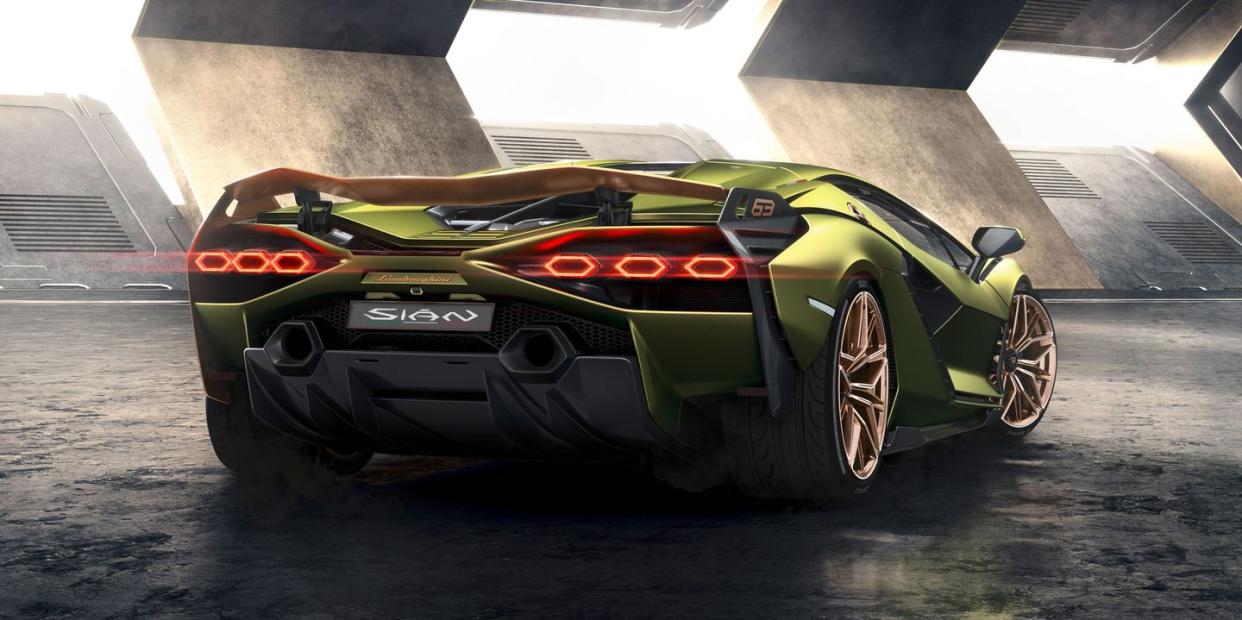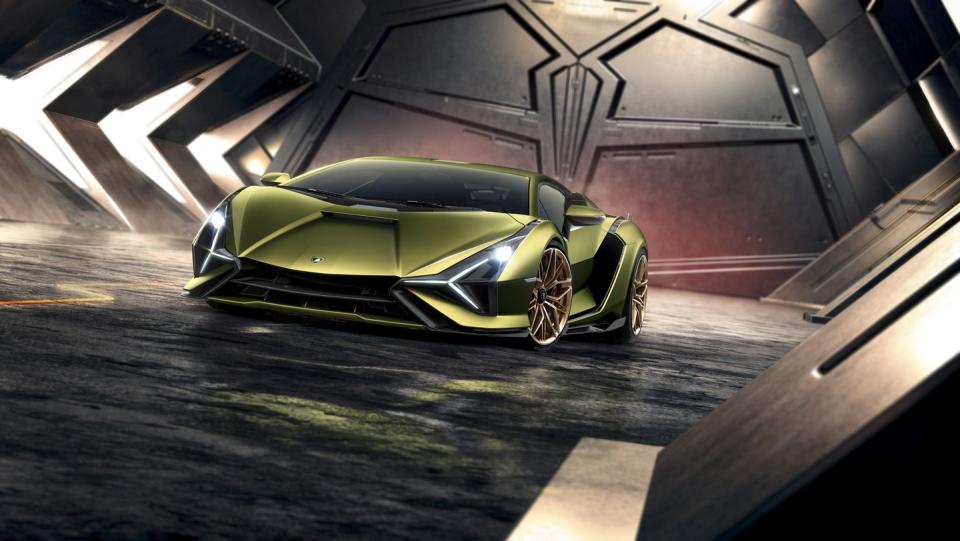Lamborghini Sián Kicks Off Lambo's Hybrid Era with 807 HP and a 218-MPH Top Speed

Lamborghini's Sián (the name means "lightning") will be produced as a limited edition of 63, all of which are already sold.
The V-12–powered hybrid makes 807 horsepower with combined thermal and electric power, including what Lamborghini claims is the world's first use of a supercapacitor in a hybrid.
Lamborghini claims a zero-to-62-mph time of less than 2.8 seconds and a top speed of 218 mph.
After eight years, the Lamborghini Aventador isn't done shocking the world with its jagged-edge design and flame-throwing exhaust. Like the Veneno and Centenario, the new Sián is a hypercar built off a heavily-modified Aventador—only now, it's a hybrid.
That the Sián's electric motor contributes but 34 horsepower to an 807-hp powertrain is the one puzzling stat. What, exactly, would anyone gain when the 6.5-liter V-12 is pushing 774 hp—15 more than the Aventador SVJ—the most ever from a Lambo engine? The engineers claim quicker midrange acceleration, better response between shifts, additional torque off the line up to 81 mph, and the convenience of parking a Lambo without the V-12 engine sputtering and begging the driver to launch out of the garage. Bless the Sant'Agata team for prioritizing objectives in their first-ever hybrid project. Engineers working on the first Honda Insight no doubt had similar wants and needs.

Based on the Terzo Millennio concept from 2017, the Sián uses a single supercapacitor stored in the bulkhead to store and expel electrical energy instead of thousands of miniature supercapacitors layered into its carbon-fiber skin. The latter method isn't science-fiction. Lamborghini has MIT scientists on the payroll figuring this out, some of whom undoubtedly contributed to the Sián's rear cooling vents and their patented "smart-material elements" that rotate using the exhaust heat. Unlike other 48-volt hybrids where the electric motor can only provide assist with the gasoline engine running, Lamborghini claims the Sián is the first such hybrid where the motor—integrated into Lamborghini's seven-speed automated manual gearbox—can power the wheels on its own at low speeds.
There's no lithium-ion battery on board. The juice comes entirely from the supercapacitor, a setup Lamborghini has used since 2011 in conventional Aventador models to run their giant starter motors. Since the big V-12 requires at least two full crank rotations before igniting during a cold start, the supercapacitor injects a headrush of current to move all that mass instead of drawing excessive loads from the 12-volt battery. In the Sián, the supercapacitor—which unlike a battery can only store energy temporarily and release it in short bursts—has 10 times the capacity. It works on the same principle as Mazda's i-ELOOP system on family sedans that are roughly one-eightieth the price of the Sián.
We're still fresh from driving an Aventador SVJ across Connecticut, so it's almost incomprehensible to imagine another Lamborghini that surges harder onto a highway (the Sián can zap from 44 to 75 mph a full 1.2 seconds quicker than the SVJ, the company claims). But we can picture merging without the SVJ's violent gear changes, or as Lamborghini puts it, those "uncomfortable jerking movements." The Sián's electric motor fills the void between the Aventador's shotgun-recoil shifts. A simpler solution would be a dual-clutch transmission like so many modern hypercars. Wait for the next one.
The Sián is the bridge between the Aventador and the Aventador's eventual replacement. Just as the Reventón previewed the Aventador while on a Murciélago frame, the Sián embodies everything Lamborghini will adopt on a future flagship. The sideways Y-shaped running lamps integrated into the carbon ductwork, more air inlets blending into the headlight housings, and yet more intakes within intakes on the rear quarter panels should all be part of the next generation. Six separate taillights, emphasizing the car's dramatic width like some sort of mutant 1960s Chevy Impala, appear to float within the engine's radiator vents. As required, the Sián evolves Lamborghini's hexagon obsession with ever more interpretations of this classic shape, such as the exhaust pipes and the molding around the backup camera.
You could spend all day and night counting the number of six-sided polygons, but what's more important is how much richer the interior looks. A vertical touchscreen like in the Huracan Evo replaces decade-old Audi A4 technology while new leather and stitching patterns for the seats, door inserts, and dash spice up an aging cabin. Lamborghini isn't convinced that cupholders or map pockets do anything important, so don't look for those.
There's no word on price, though all customers have put down deposits for the 63-car run and enjoy the unique position of being the first Lamborghini owners to spec 3D-printed leather. With the SVJ Roadster barely on sale, we're still a ways off from seeing a true Aventador replacement whose owners can legitimately park in the green vehicle spaces at Whole Foods.
You Might Also Like

